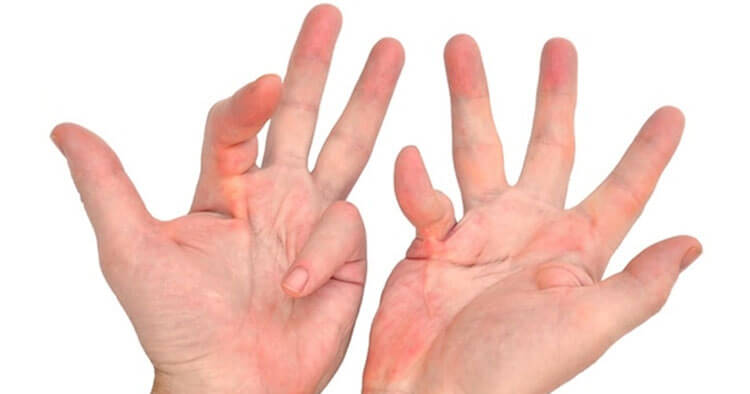Surgical Procedures and Protocols
Treatment For Dupuytren’s Disease
The Causes Of Dupuytren’s Disease
It is unknown exactly what causes Dupuytren’s disease, the current understanding is that genetics play an important role. Although there are anecdotal reports of the onset of Dupuytren’s contractures following injury to the hand, or over use of the hands. Overuse such as involvement in occupations requiring manual labour, particularly the use of vibration tools, however to date there isn’t any quality evidence to support these beliefs.
Risk Factors For Dupuytren’s Disease
Some of the risk factors believed to contribute to the development, or worsening of Dupuytren’s contractures include:
- Gender: Males are more likely to develop Dupuytren’s contractures and when developed typically have more severe contractures than women.
- Age: Incidence increases with age, with the condition most commonly affecting males beyond the age of 50.
- Familial History: Dupuytren’s disease tends to run in families, frequently finding individuals suffering with the condition are likely to have a direct relative who also has the condition.
- Ancestry: Northern Europeans and Scandinavians are more likely to develop the condition. Giving it the name Vikings disease.
- Tobacco and Alcohol: Smoking and alcohol intake is also associated with Dupuytren’s contractures.
- Medical Conditions: Diabetics are reported to have an increased risk of Dupuytren’s disease. This is similar to another condition called a frozen shoulder which has an increased incidence in diabetics and those with an overactive or underactive thyroid. Someone who has Dupuytren’s contractures are more likely to suffer a frozen shoulder and this association raises suspicions around the causes of these conditions and an autoimmune component.
Diagnosis Of Dupuytren’s Disease
Diagnostic tests are rarely necessary as generally the diagnosis is a clinical one can be made via the look and feel of the hand/s.
- Examination of the hand/s will include checking for puckering of the skin of the palms and palpation for toughened nodules, or cords of tissue.
- As well as measuring the range of motion of the fingers and thumb which can be used to track any progression of the disease.
- The use of the “tabletop test” is a very quick test used in the diagnosis of Dupuytren’s disease. This tests as it hints, is where the individual is examined to see if the affected hand can be placed flat on a table (or similar flat surface). With Dupuytren’s disease in its more advanced stages, the individual will not be able to fully flatten their fingers on to the table, indicating the presence of a Dupuytren’s contracture.
Documentation of the hand in various ways, sometimes via photographs, recording the size and location of any nodules and cords, as well measuring range of movement can all be used over the course of the condition. Doing this gives the ability to assess whether the disease is progressing over time and if any intervention should be engaged.
Treatment Of A Dupuytren’s Contracture
There is no cure for Dupuytren’s disease and any progression of the disease varies from one individual to the next, even varying from one hand to the next. Usually it progresses very slowly over time (years) and generally as rule, as a contracture worsens over time as involvement of the fascia becomes more severe. As a result over time where there is greater fascial involvement any treatment is less likely to result in full resolution of the problem.
Nonsurgical and Surgical Options:
- The use of steroid injections may slow the progression of a contracture. A Corticosteroid injection is the use of a powerful anti-inflammatory medication injected directed into one or more of the painful nodules, providing relief of discomfort or assisting in slowly the process of cord formations.
- The use of enzyme injections is a relatively new approach to managing Dupuytren’s contractures. With this procedure a type of enzyme is injected into the tight cord in an attempt to soften and weaken it. After this some time later it allows manipulation of the hand and fingers by the doctor in an attempt to break, or pull apart the restrictive cords ultimately freeing up movement and improving hand posture.
- Needling (needle aponeurotomy) uses a needle, inserted through your skin, back and forth targeting the restrictive cords with the goal of weakening and rupturing the diseased tissue causing the contractions.
- Surgical treatment is often sought if the contracture interferes with hand function. Where the goal of surgery is to reduce the contracture, improving the motion and resting posture in the affected fingers. Unfortunately post surgically the healing tissues will form with the same potential to develop cords in the future. The gains in hand function can still be substantial and warrant the procedure. Surgery is the most common type of treatment offered for the condition yet unfortunately, it is not guaranteed that surgery will cure the disease and contractures and functional limits return over time post-surgically.
Disclaimer: Sydney Physio Clinic provides this information as an educational service and is not intended to serve as medical advice. Anyone seeking specific advice or assistance on Treatment For Dupuytren’s Disease should consult his or her physiotherapist, general practitioner or otherwise appropriately skilled practitioner.


